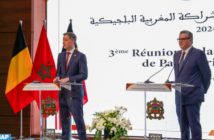[tentblogger-youtube PSR3_ZEEp60]
Nefertari
Centodieci anni fa, grazie all’intuizione dell’archeologo italiano Ernesto Schiapparelli, venne scoperta la tomba della regina Nefertari. In coincidenza con questo storico anniversario, l’Ambasciata italiana e l’Istituto di Cultura italiana del Cairo, in collaborazione con il Ministero dell’Antichità egiziane hanno inaugurato al Museo Egizio la mostra fotografica “Nefertari 1904-2014”. La tomba di Nefertari è considerata la più bella tra quelle dedicate alle regine egiziane e il suo stesso scopritore la descrisse a suo tempo come il più importante dei monumenti della necropoli di Tebe, non per la sua grandezza, ma soprattutto per l’armonia delle sue parti e la delicatezza dell’arte, alla stessa maniera in cui compete con le più belle delle tombe della Valle dei Re. La tomba fu scoperta nel 1904 e restaurata in parte da Stopplair (1949) e poi messa in sicurezza dal Paul Getty ( 1985 – 1992) e da un’ equipe italiana diretta da Paolo Mora.
L’ambasciata italiana l’ha definita uno straordinario esempio di committenza e qualità del lavoro di archeologi e restauratori che conferma il grande valore della presenza italiana in Egitto, che è forte ancora oggi con 23 missioni che operano sul territorio.
La mostra è stata sponsorizzata dall’ Alex Bank, Intesa Sanpaolo e Bcube logistics Coniolo (AL) ed è stata presentata alla stampa alla presenza dell’ambasciatore italiano Maurizio Massari e dal Ministro delle antichità, Eldamaty, per poi essere trasferita ad Alexandria e Luxor.
About Nefertari: “The one for whom the sun shines”:
[tentblogger-youtube L6cw6FUS_As]
Nefertari Merytenmut fu una delle Grandi Spose Reali, la principale e favorita di Ramses II il Grande, che la chiamava “Colei sulla quale il sole brilla”, ma anche “la più bella” e “la più amata”. La sua fama eguaglia quella delle più note regine dell’antico Egitto come Cleopatra, Nefertiti o Hatshepsut. La sua spettacolare tomba decorata è tra le più grandiose della Valle delle Regine.
Il Faraone per lei costruì anche un tempio ad Abu Simbel vicino al suo gigantesco monumento.
A Nefertari vennero concessi diversi titoli, tra i quali di “Dolcezza d’amore”, “Signora della grazia”, “Grande sposa del re”, “Signora delle due terre”, “ Moglie di dio” , “Amante del basso e dell’alto Egitto”. La celebre regina compare come moglie di Ramsess II in alcune scene ufficiali che risalgono al primo anno del regno di Ramses ed è una presenza importante sui monumenti ritrovati a Luxor e Karnak, in alcuni frammenti compare alla guida di uno stuolo di bambini reali, nel suo ruolo mai spodestata, come testimonia l’iconografia, dall’altra consorte del Faraone Isinofret. E che avesse anche un ruolo politico di primo piano è provato dal fatto che inviò una lettera di auguri alla moglie del re ittita Pudujepa dopo la firma del trattato di pace.
About Ernesto Schiaparelli
Ernesto Schiaparelli (Occhieppo Inferiore nel biellese 1856-1928) è stato un grande egittologo italiano. Scoprì la tomba della bella sposa di Ramses II a Deir el-Medina nella Valle delle Regine nel 1904 e diresse anche gli scavi che portarono alla scoperta della tomba dell’architetto reale Kha (1906), trovata intatta ed esposta a Torino.
Fu nominato direttore del museo egizio di Firenze dove nel 1880 riorganizzò la collezione e poi all’ apice della sua carriera divenne direttore del museo egizio di Torino che grazie a lui ai suoi scavi è diventato il secondo più grande museo egizio nel mondo. Fu autore di numerosi saggi e senatore del regno d’Italia. Dopo la sua fre quentazione dei missionari francescani a Luxor nel 1884, fondò l’associazione per il soccorso dei missionari italiani (ANSMI), che estese poi la sua opera a sostegno di tutti gli emigrati italiani in Medio Oriente. Tra il 1903 e il 1920 Schiaparelli diresse dodici campagne archeologiche aprendo siti a Giza, Hermopolis, Assiut, Qau el-Kebir, Gebelein e Aswan.
About Nefertari
Queen Nefertari celebrates 110 years the discovery of her tomb. The discovery of the tomb of Queen Nefertari, thanks to the preparation and intuition Italian archaeologist Ernesto Schiaparelli, celebrates 110 years. For the occasion, the Italian Embassy and the Italian Cultural Institute in Cairo, in collaboration with the Ministry of Antiquities of Egypt, inaugurates on December 8, at 6:00 pm, at the Egyptian Museum, the photo exhibition “Nefertari 1904-2014”.
“The tomb of Nefertari is considered the most beautiful among those dedicated to the Egyptian queens and the same Italian archaeologist Schiaparelli described it as “one of the most important monuments of the necropolis of Thebes that if not for amplitude, certainly for the harmony of its parts and the delicacy of the art, while Anco competes with the finest tombs of the Valley of the Kings. The tomb was discovered in 1904, restored in part by Stopplair (1949) and then saved by the Paul Getty (1985-1992) and an Italian equipe directed by Paolo Mora.
It therefore emphasizes the embassy, an extraordinary example of the commitment and quality of work of archaeologists and restorers Italian and especially the confirmation of the great value of the Italian presence in the archaeological Egyptian presence still relevant today, with 23 missions currently operating throughout Egypt. The exhibition, sponsored by Alex Bank, Intesa Sanpaolo Group of Turin and Bcube logistics Coniolo (AL), will be presented to the press in the presence of the Ambassador of Italy, Maurizio Massari, and the Minister of Antiquities, Eldamaty, and will subsequently transferred to Alexandria and Luxor.
Source
About Nefertari: “The one for whom the sun shines”:
Nefertari Merytenmut was one of the Great Royal Wives (the Main & favorite) of Ramesses II the Great. Nefertari-Merytenmut (“The most Beautiful” and “Beloved of Mut”) is one of the best known Egyptian queens, like Cleopatra, Nefertiti or Hatshepsut. Her Spectacullar decorated tomb, is the largest and most spectacular in the Valley of the Queens. Ramesses also constructed a temple for her at Abu Simbel next to his colossal monument.Ramesses II also named her “The one for whom the sun shines”
Nefertari held many different titles, including: Sweet of Love , Lady of Grace , Great King’s Wife , Lady of The Two Lands, God’s Wife, Mistress of Upper and Lower Egypt Etc. Nefertari first appears as the wife of Ramesses II in official scenes during the first year of Ramesses II. Nefertari is an important presence in the scenes from Luxor and Karnak. In a scene from Luxor, Nefertari appears leading the royal children.
Nefertari was the favorite and that can be seen in the monuments, since the statues and scenes depicted we always see nefertari and not isisnofret, isisnofret also never had a spectacullar tomb like Nefertari, and even less a temple like Abu Simbel dedicated to her. Nefertari also had a prominent role in policy in fact she was who sent a letter of greetings and best wishes to the Hittite king’s wife Pudujepa after the peace treaty.
About Ernesto Schiaparelli
Ernesto (1856-1928) was an Italian Egyptologist, born in Occhieppo Inferiore (Biella), who found Queen Nefertari’s tomb in Deir el-Medina in the Valley of the Queens (1904) and excavated the TT8 tomb of the royal architect Kha (1906), found intact and displayed in toto in Turin. He was appointed director of the Egyptian Museum in Florence, where he professionally reorganized the collection in new quarters in 1880, then at the peak of his career was made director of the Museo Egizio di Torino, which became with him and his many seasons of excavating, the second biggest Egyptian museum in the world.
He was the author of famous scholarly works and a Senator of the Kingdom of Italy. At the same time, he was deeply involved, from his first stay with Franciscan missionaries at Luxor in 1884, with relieving the poverty he saw among the missionaries of Upper Egypt, for whom he founded the Association to Succour Italian Missionaries (ANSMI), which expanded its work to care for Italian emigrants throughout the Near East.
Between 1903 and 1920 Schiaparelli undertook twelve archaeological campaigns, opening sites in Heliopolis, the cemeteries of Giza, Hermopolis, Assiut, Qau el-Kebir, Gebelein and Aswan (the tomb of Harkhuf)
[tentblogger-youtube KoMqbVsDZSo]
Paul Attallah



